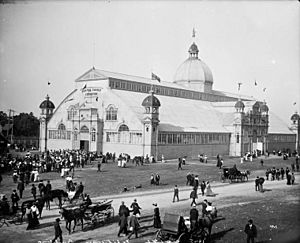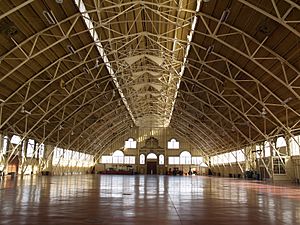Aberdeen Pavilion facts for kids
Quick facts for kids Aberdeen Pavilion |
|
|---|---|
|
Pavillon Aberdeen
|
|

The Aberdeen Pavilion in 2021
|
|
| Former names | "Cattle Castle" (informal) |
| General information | |
| Type | Exhibition Hall |
| Architectural style | Victorian |
| Address | 1000 Exhibition Way Ottawa, Ontario K1S 5J3 |
| Coordinates | 45°24′00″N 75°40′58″W / 45.4001°N 75.6828°W |
| Completed | 1898 |
| Cost | CA$75,000 (1878) |
| Owner | City of Ottawa |
| Design and construction | |
| Architect | Moses C. Edey |
| Awards and prizes | Designated under the Ontario Heritage Act |
| Official name: Aberdeen Pavilion National Historic Site of Canada | |
| Designated: | 1983 |
| Type: | Municipal Heritage Designation (Part IV) |
The Aberdeen Pavilion is a cool old building in Ottawa, Ontario, Canada. It's also known as Pavillon Aberdeen in French. You can find it in Lansdowne Park, which is a historic fairground. The building looks out over the Rideau Canal.
For many years, people called it the "Cattle Castle". This was because it was used for showing farm animals at the Central Canada Exhibition. It's the last building of its kind left in Canada. It shows a style of building called Victorian exhibition halls. Because it's so special, it became a National Historic Site of Canada in 1983.
The Aberdeen Pavilion is also one of the oldest indoor places in the world where ice hockey was played. Even though hockey isn't played there anymore, it's the oldest place where the famous Stanley Cup was once competed for. This happened during Stanley Cup challenge matches in 1904. The Ottawa Hockey Club played against other teams there.
Contents
A Look Back: The Pavilion's History
The Aberdeen Pavilion was built in 1898. Its main job was to be the central hall for the Central Canada Exhibition. A talented architect named Moses C. Edey designed it. He got his ideas from a famous building in London called the Crystal Palace.
The building was named after Lord Aberdeen. He was the Governor General of Canada at the time and officially opened the pavilion. The Dominion Bridge Company built the structure. It only took two months to finish and cost about $75,000 back then. The building has huge steel arches that hold up the roof. This design creates a massive open space inside, about 3,000 square meters, with no columns in the way.
For many years, the pavilion was mostly used for agricultural shows. This is how it got its nickname, "Cattle Castle." During wartime, the building played an important role for the military. Soldiers from Strathcona's Horse gathered there before going to the Boer War. In the First World War, it was where the Princess Patricia's Canadian Light Infantry met up. It also served as a place to sign up new soldiers during the Second World War. It was home to the Cameron Highlanders of Ottawa and the 4th Princess Louise Dragoon Guards then.
Saving the Pavilion: Restoration Efforts
In 1982, the Aberdeen Pavilion was officially recognized as a heritage building. This meant it was important to protect its history. However, the building was getting old and needed a lot of repairs. These repairs would cost millions of dollars. The pavilion had been closed for years because of serious problems with its structure. Many windows were broken, paint was peeling, and someone had even painted "Cattle Castle" on the front.
The City Council agreed to help pay for the repairs. But the federal and provincial governments didn't want to give money. In 1991, the Ottawa City Council voted to tear down the building instead of paying for all the repairs. This decision became a big topic in the city's election that year. In 1992, the City Council changed its mind. They approved a plan to fix up the building for $5.3 million. The newly restored pavilion opened its doors again in 1994.
In 2000, the Royal Architectural Institute of Canada named the Aberdeen Pavilion as one of the top 500 buildings made in Canada over the last 1,000 years.
What the Pavilion is Used For Today
The pavilion used to be a place to show cattle for the Central Canada Exhibition. That exhibition doesn't happen anymore. Today, the pavilion is used for many different special events. Since 2015, it has hosted the Ottawa CityFolk Festival every September. It's also home to a farmer's market during the colder months. In the summer, the market moves outside. You can also find a Christmas market there in December.
In 2017, the pavilion hosted a big professional wrestling show. It was Impact Wrestling's annual Bound for Glory event.
Sports and the Pavilion
In 1902, the Ottawa Senators hockey team, then called the Ottawa Hockey Club, built a hockey rink inside the Pavilion. In 1904, the team played their entire season and Stanley Cup challenge games there.
In 1918, the Ottawa Senators almost moved back to the Pavilion. They looked into fixing it up to be a hockey arena again. However, the City of Ottawa wasn't ready to put an ice rink back inside. This was because bleachers, or seating, had been built inside the building.
In 2017, the Aberdeen Pavilion was part of the NHL 100 Classic celebrations. It hosted fun events, exhibits, and places to buy merchandise. After more than 110 years, the Stanley Cup itself returned to the Pavilion for a special display! The actual hockey game for the NHL 100 Classic was played outdoors nearby on the TD Place football field. It was a game between Ottawa and Montreal.
See also
- Ice hockey in Ottawa




